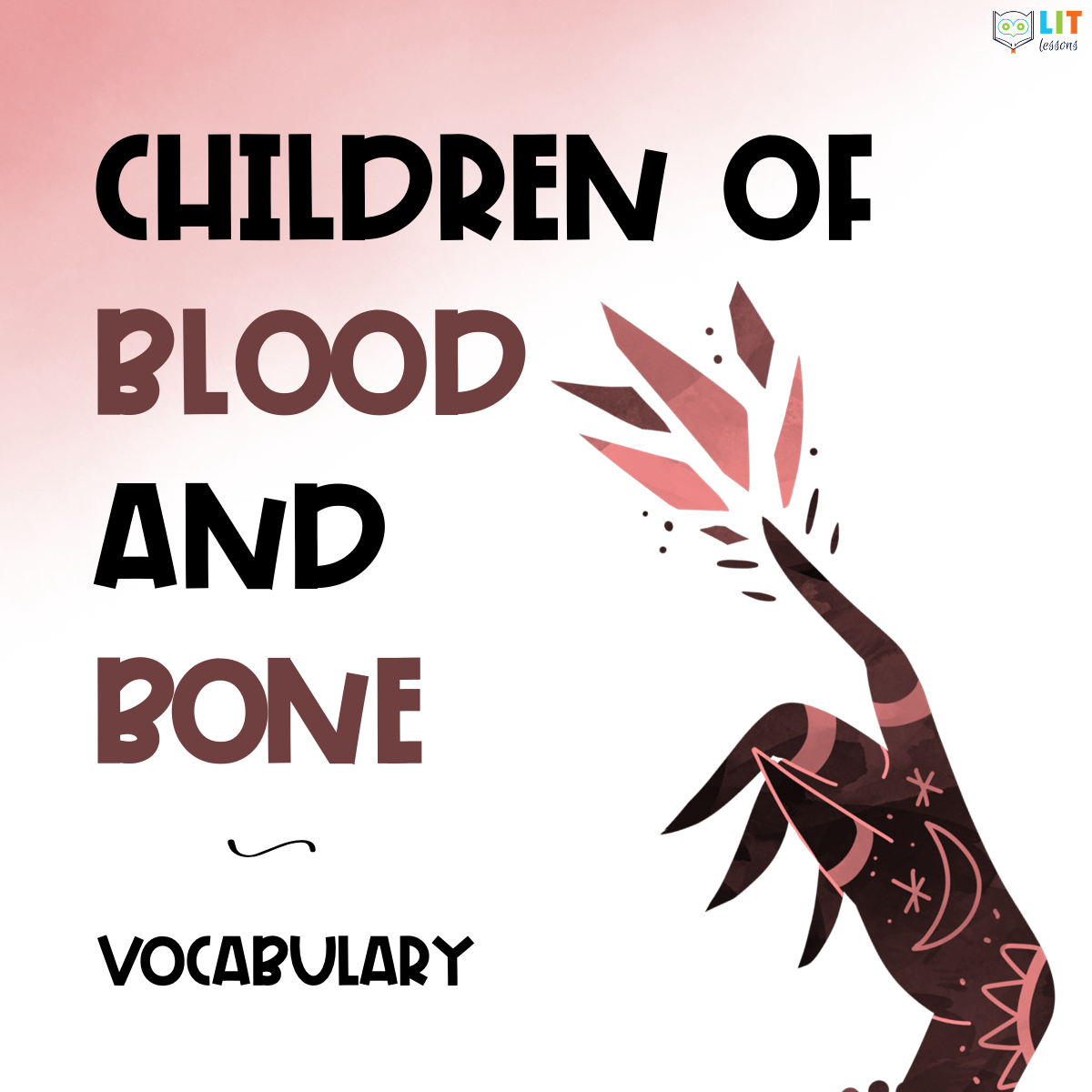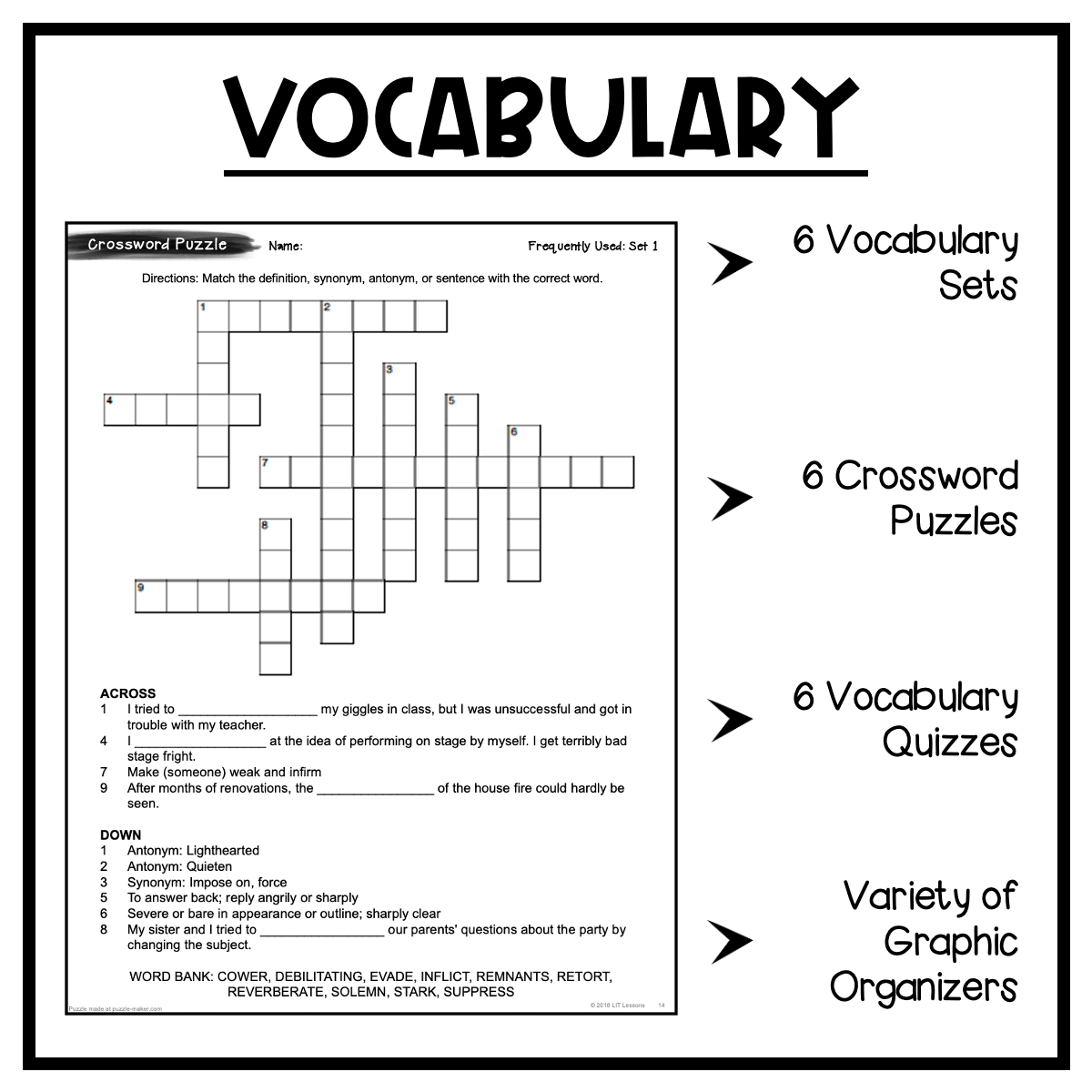Children of Blood and Bone Vocabulary
You can only add to a wishlist if you have an account, please register now.
Create an Account$4
Children of Blood and Bone Vocabulary – Snapshot of Included Resources:
- 2 Vocabulary Sets – 6 Lists
- 6 Crossword Puzzles
- 6 Quizzes
- Variety of Graphic Organizers
- Digital Links for Google Drive™
- Includes Google Forms™!
- Answer Keys!
Teaching vocabulary is an important part of any lesson. The vocabulary resources will help students learn, acquire, and utilize new words in their writing and speaking. The vocabulary resources will assist students in building their own vocabulary and engage them in varied activities to maximize their vocabulary’s expansion. Below is an outline of the resources included to help teach frequent and/or challenging vocabulary words in Children of Blood and Bone and build your students’ vocabulary knowledge.
- ZIP file (PDFs and Word Docs for Digital Links)
- Non-Editable
- 2.76 MB
- 44 Pages
- Links for Student Pages in Google Slides™ & Google Forms™
- This downloadable resource supplies one single-teacher license for use in your classroom.
- Photocopying of this product is allowed only for the classroom use of the purchaser.
- Replication of this product, in whole or in part, for commercial sale or broader distribution is strictly prohibited.
- This product also may NOT be shared electronically, digitally, or otherwise in a manner that violates the Terms of Use detailed by LIT Lessons.
- For explicit information on permissions, please see the Terms of Use document included with this resource. Thank you for your cooperation and understanding.
Children of Blood and Bone Vocabulary – Snapshot of Included Resources:
- 2 Vocabulary Sets – 6 Lists
- 6 Crossword Puzzles
- 6 Quizzes
- Variety of Graphic Organizers
- Digital Links for Google Drive™
- Includes Google Forms™!
- Answer Keys!
Teaching vocabulary is an important part of any lesson. The vocabulary resources will help students learn, acquire, and utilize new words in their writing and speaking. The vocabulary resources will assist students in building their own vocabulary and engage them in varied activities to maximize their vocabulary’s expansion. Below is an outline of the resources included to help teach frequent and/or challenging vocabulary words in Children of Blood and Bone and build your students’ vocabulary knowledge.
- ZIP file (PDFs and Word Docs for Digital Links)
- Non-Editable
- 2.76 MB
- 44 Pages
- Links for Student Pages in Google Slides™ & Google Forms™
- This downloadable resource supplies one single-teacher license for use in your classroom.
- Photocopying of this product is allowed only for the classroom use of the purchaser.
- Replication of this product, in whole or in part, for commercial sale or broader distribution is strictly prohibited.
- This product also may NOT be shared electronically, digitally, or otherwise in a manner that violates the Terms of Use detailed by LIT Lessons.
- For explicit information on permissions, please see the Terms of Use document included with this resource. Thank you for your cooperation and understanding.



More Children of Blood and Bone Resources...
Children of Blood and Bone Novel Study
The Children of Blood and Bone Novel Study is a comprehensive set of standards-aligned instructional materials for teaching Children of Blood and Bone by Tomi Adeyemi. With over 100+ materials, students will deeply engage with the novel and develop their literacy skills. The close reading activities, literary analysis resources, West Africa and Yoruba historical and cultural readings and activities, vocabulary, assessments, and final projects all provide opportunities for your students to practice and apply what will be their growing understanding of the novel. They also provide numerous ways for you to DIFFERENTIATE learning for your students, allowing you to choose the assignments that best support your students’ learning while being conducive to any classroom model.
Children of Blood and Bone Chapter Questions
For the novel Children of Blood and Bone, 30 literary analysis assignments provide a framework for students to complete a deep analysis of each chapter grouping in the book The assignments are aligned to the Common Core State Standards. They are designed not only to have students practice literacy skills but also demonstrate their comprehension of the text. It could supply homework, facilitate guided reading groups, or stimulate whole class literacy discussions for each chapter.
Children of Blood and Bone Close Readings
The 30 close reading lessons explicitly focus on critical Common Core Standards to develop students’ literacy proficiency. Using Children of Blood and Bone as the foundational text for close reading, each lesson focuses on a particular skill, such as setting, conflict, tone, and plot, and provides students an opportunity to develop and demonstrate their ability to perform that skill. Each assignment also requires students to use textual evidence to support their claims. The resources could supply homework, facilitate guided reading groups, or stimulate whole class literacy discussions for each chapter grouping. You can choose the purpose that best suits your students and your classroom.
Children of Blood and Bone Assessments
The standards-aligned assessments will help you measure your students’ comprehension of Children of Blood and Bone and their ability to apply the literary skills taught throughout the unit. The materials include 30 reading checks, 4 novel quizzes, 2 final assessments, and essay choice board.
Children of Blood and Bone Nonfiction Readings & Activities
The 10 nonfiction articles will help your students understand the key settings and time periods that shape Children of Blood and Bone. Articles on West Africa and Yoruba history and culture will aid students’ comprehension by providing background knowledge about the context that shapes the novel. While building their knowledge with these resources, students will be tasked with synthesizing information across the novel and these texts. In doing so, the 5 extension activities provide additional opportunities for students to develop essential critical thinking skills.
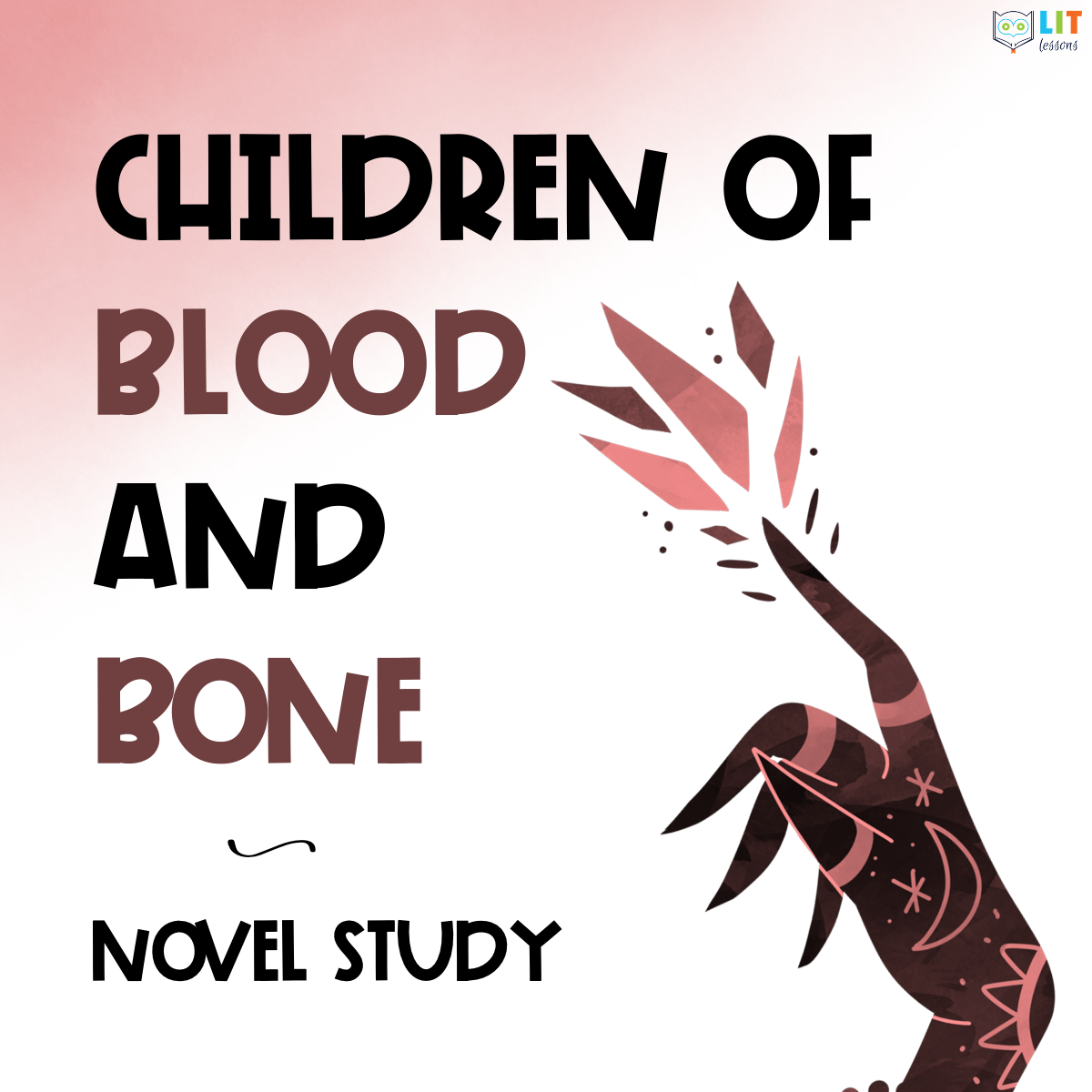
Children of Blood and Bone Novel Study
The Children of Blood and Bone Novel Study is a comprehensive set of standards-aligned instructional materials for teaching Children of Blood and Bone by Tomi Adeyemi. With over 100+ materials, students will deeply engage with the novel and develop their literacy skills. The close reading activities, literary analysis resources, West Africa and Yoruba historical and cultural readings and activities, vocabulary, assessments, and final projects all provide opportunities for your students to practice and apply what will be their growing understanding of the novel. They also provide numerous ways for you to DIFFERENTIATE learning for your students, allowing you to choose the assignments that best support your students’ learning while being conducive to any classroom model.

Children of Blood and Bone Chapter Questions
For the novel Children of Blood and Bone, 30 literary analysis assignments provide a framework for students to complete a deep analysis of each chapter grouping in the book The assignments are aligned to the Common Core State Standards. They are designed not only to have students practice literacy skills but also demonstrate their comprehension of the text. It could supply homework, facilitate guided reading groups, or stimulate whole class literacy discussions for each chapter.
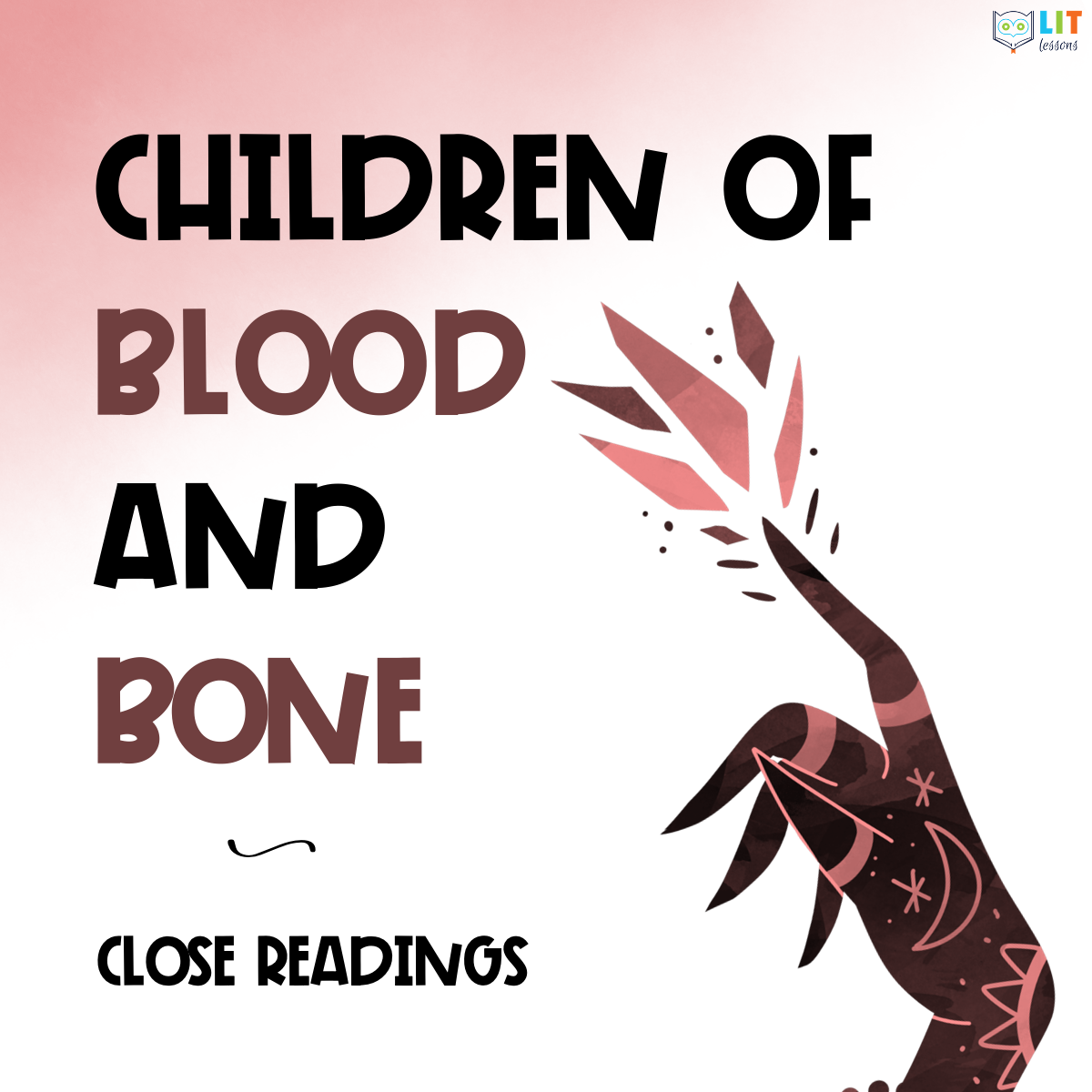
Children of Blood and Bone Close Readings
The 30 close reading lessons explicitly focus on critical Common Core Standards to develop students’ literacy proficiency. Using Children of Blood and Bone as the foundational text for close reading, each lesson focuses on a particular skill, such as setting, conflict, tone, and plot, and provides students an opportunity to develop and demonstrate their ability to perform that skill. Each assignment also requires students to use textual evidence to support their claims. The resources could supply homework, facilitate guided reading groups, or stimulate whole class literacy discussions for each chapter grouping. You can choose the purpose that best suits your students and your classroom.

Children of Blood and Bone Assessments
The standards-aligned assessments will help you measure your students’ comprehension of Children of Blood and Bone and their ability to apply the literary skills taught throughout the unit. The materials include 30 reading checks, 4 novel quizzes, 2 final assessments, and essay choice board.
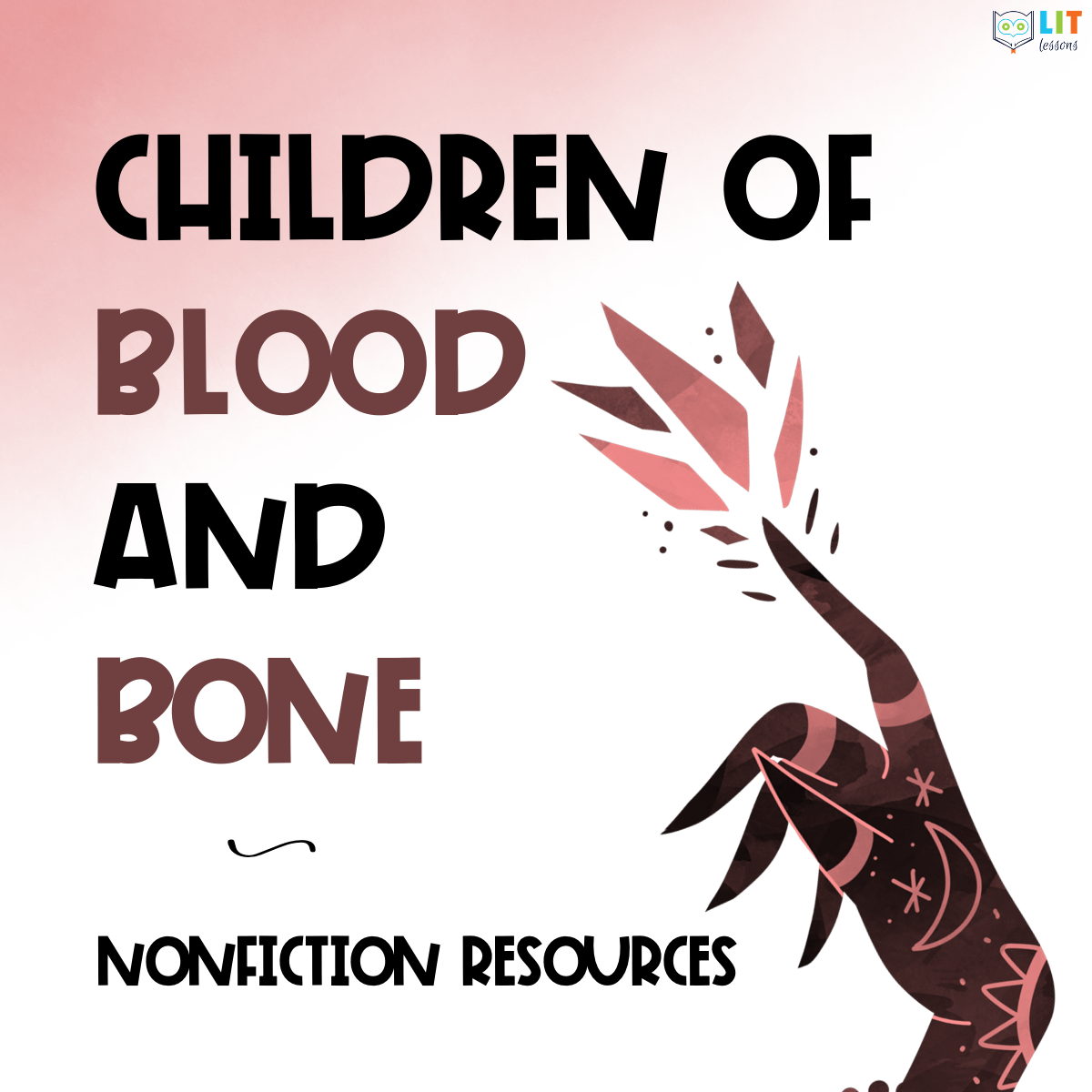
Children of Blood and Bone Nonfiction Readings & Activities
The 10 nonfiction articles will help your students understand the key settings and time periods that shape Children of Blood and Bone. Articles on West Africa and Yoruba history and culture will aid students’ comprehension by providing background knowledge about the context that shapes the novel. While building their knowledge with these resources, students will be tasked with synthesizing information across the novel and these texts. In doing so, the 5 extension activities provide additional opportunities for students to develop essential critical thinking skills.

